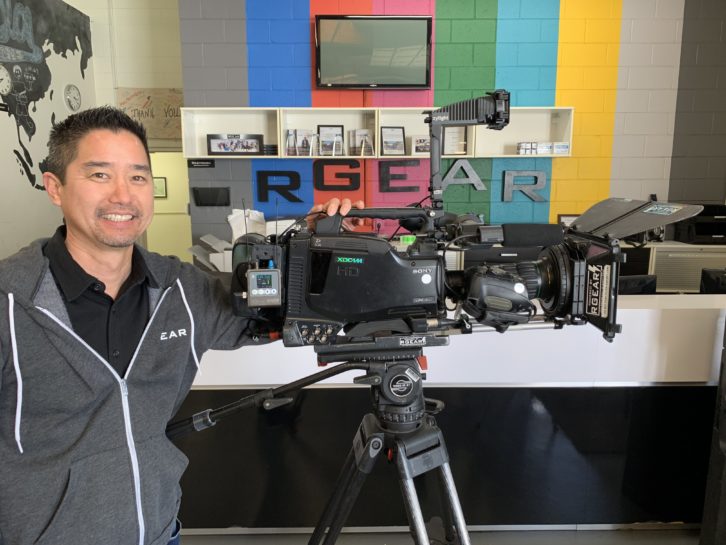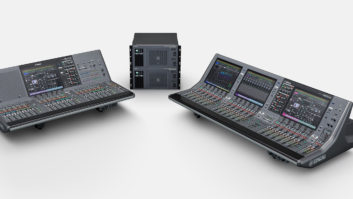
Los Angeles, CA (April 15, 2020) — Reality TV series have different production workflows than scripted dramas. The cast are not professional actors, multiple camera operators film different cast member interactions at once, showrunners need to listen in on what’s going on at a moment’s notice, and it all needs to be turned around in post on an impossibly tight schedule. To tackle these challenges on ABC’s ever-popular The Bachelor, sound contractor and equipment supplier RGEAR — a pioneer in production sound for reality television — turned to Lectrosonics gear, including DCHT stereo digital transmitters and M2R wireless IFB stereo receivers, both part of the Duet family of monitoring solutions.
“We might have up to 14 cameras running at the same time,” says Dan Norton, audio supervisor on The Bachelor. “For each camera, there’s a mixing person running around with an audio bag to capture all the different scenarios. DCHT transmitters ‘hop’ the stereo mix from each bag to the M2R receiver, which is also stereo, that’s mounted on each camera.”
“Though we record multi-track audio at the location and in the field, we’re also recording ENG-style direct to the cameras, which is what the Lectrosonics gear is for,” adds RGEAR owner Gregg Kita. “Due to the time crunch factor, the post-production crew only uses the multi-track audio when they need to. They like to rely on the ENG mixers to give them good stereo mixes on the cameras. Our crews are trained to send properly gain-staged sound to the cameras, which have a high-quality audio input stage. With the fidelity of the DCHT and M2R, the camera audio is good enough to be what you hear on television much of the time.”
To stay on top of all the developing intrigue, one or more producers patrol the location and need to be able to hear any cast conversation at any time, often quickly switching if a given interchange gets particularly interesting. For this, “we also have an M2R with an in-ear monitor on each producer’s hip,” says Dan Norton. “The M2R has a feature called Flex List, which is basically a list of mixes and the frequencies they’re on. It can save up to 16 of them, and you can give them custom names [in Lectrosonics Wireless Designer software]. So, a producer can elect to hear the output of any bag’s DCHT at any time themselves, without having to call on an operator to send them a different mix — almost like changing stations on a car radio.”
Economy of frequencies is another concern that Lectrosonics helped address, as Gregg Kita details: “With the sell-off of a lot of the RF spectrum to cell phone carriers, for 5G and Wi-Fi, and so on, Lectrosonics’ technology has enabled us to pack more usable channels into less bandwidth. In addition to that, the pairing of the DCHT and M2R realized a desire we first had, oh, ten or more years ago: To handle stereo audio to the camera and the producers’ IFB on a single radio frequency.”
“That’s because of the digital encoding in the DCHT and M2R,” Norton elaborates. “Back in the day on The Bachelor, we needed two transmitters in each bag and two receivers on each camera. Then we needed a third transmitter-receiver pair because the producer wanted to hear a mono mix. So, 14 cameras times three is 42 frequencies, and that’s before we’d even miked up a single cast member! The show traveled all over the world in all kinds of RF surroundings, so frequency coordination was always time-consuming.”
“Using the current setup, we’re down to 14 frequencies to cover all the hops and IFB,” says Kita. “With the M2R, producers can opt to hear a stereo mix, a mono fold-down, or each channel separately. The infrared pairing between the receivers and transmitters is fantastic, and the frequency co-ordination that used to take several hours when we first arrived at a new location is down to about an hour.”
Range and reliability are the cherry on the cake for RGEAR. “Lectrosonics is top of the list when it comes to range at a given output power on the transmitter,” remarks Kita. “And many sound people who work on reality TV are freelancers, and they come in knowing the gear is time-tested and proven. Everyone knows and trusts Lectrosonics.”
About Lectrosonics
Well respected within the film, broadcast, and theatre technical communities since 1971, Lectrosonics wireless microphone systems and audio processing products are used daily in mission-critical applications by audio engineers familiar with the company’s dedication to quality, customer service, and innovation. Lectrosonics received an Academy Scientific and Technical Award for its Digital Hybrid Wireless® technology and is a US manufacturer based in Rio Rancho, New Mexico. Visit the company online at www.lectrosonics.com.







